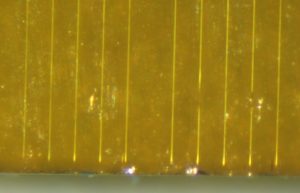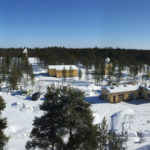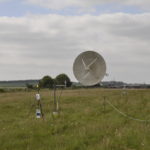Mid-infrared photonics – laser inscribed optical components

Laser inscribed single mode waveguides in chalcogenide glass. Each waveguide has a square cross-section, approximately 20 um wide.
Ultrafast laser inscription (ULI) of glasses is known to produce single- and multi-mode waveguides, which, to date, have mostly been demonstrated in the near-infrared telecommunications band. Use of the multi-scan technique allows fabrication of modified refractive index regions with larger cross-sections, implying that waveguides suitable for guiding in the mid-infrared spectral region can be achieved, in suitable transmissive materials. Chalcogenide glasses have transmission characteristics that promote their use in the mid-infrared, with various potential applications in astrophotonics, molecular spectroscopy, and remote or in-situ sensing. Such materials can be transmissive across both atmospheric windows (3–5 and 8–12 μm), and are thus potentially well suited for these applications.
In addition to waveguide structures, ULI can also be used to fabricate volume transmission gratings in similar materials. These operate in transmission mode in the mid-infrared spectral region, and devices with peak diffraction in the atmospheric windows have potential use in remote atmospheric sensing and molecular spectroscopy, in addition to astrophotonics. Use of the High-Resolution Spectroscopy Facility enables fabricated gratings to be characterized with ease.
Development of these mid-infrared photonic components forms a programme of work designed to enhance our mid-infrared gas sensing capability, by applying these novel technologies to emulate mature near-infrared sensing components in the mid-infrared spectral region. The group collaborates with Heriot Watt University and the Astronomy Technology Centre in Edinburgh on this topic. Dedicated characterization facilities have been developed to allow rapid design-fabricate-test cycles. Advanced modelling capability underpins device development. Contact the Laser Spectroscopy team if your application could benefit from these technologies.
 Previous Post
Previous Post Next Post
Next Post